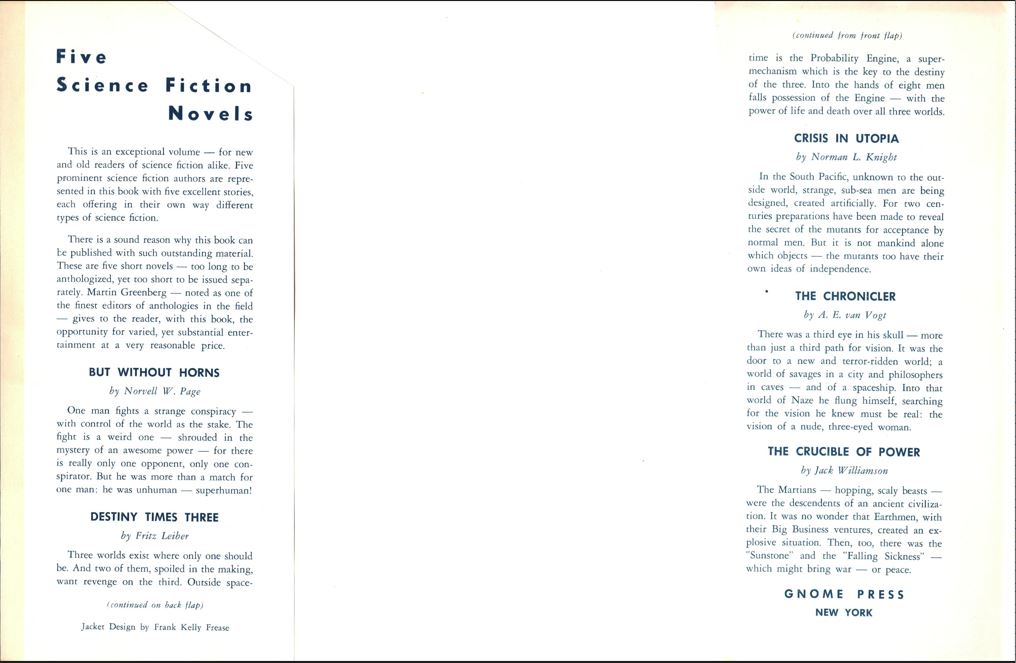Gnome Notes
In a departure from his Adventures in Science Fiction series anthologies, Marty Greenberg plucked five longer works from John W. Campbell magazines for this anthology. Compared to those, his pet project, the presentation here is distinctly second rate – no introduction or foreward or embossed spaceship on the cover cloth. Yet it had the second largest original print run of any Gnome Press item, 6500 copies, a mark that didn’t fall until 1958 when the return of Robert A. Heinlein with Methuselah’s Children earned a 7500-copy flood of print. Many are the ways of Gnome unfathomable.
Calling these stories “novels” is another puzzler. A quick estimate puts the total word count at around 150,000, at which point modern fantasists are still introducing new characters to march to a far-distant end. Both the Hugo and Nebula Awards define an eligible novel as one of at least 40,000 words, though, a reflection of the times in which they were created. “Novels” once were almost always much shorter on average than today’s works, especially during the pulp era. Magazines liked to boast that they contained entire novels, necessitating that the word count stayed below a set maximum, and while some of these were expanded for book form, others went through as typeset. Thin paperbacks were common when those came into play in the 1950s and 1960s; two titles bound together, as in the Ace Double series, seemed to give twice the reward but generally ran only 250 pages.
Yet, even by that skimpy standard, these selections lack heft. Only the Page and Leiber entries remotely qualify as novels; the Knight and Vogt are novellas, today classed as between 17,500 and 40,000 words; the Williamson is a mere novelette, probably under 15,000 words. The book is a cheat, so much so that even contemporary reviewers recognized the fact.
Greenberg calls himself the “compiler” rather than the editor.
Reviews
Basil Davenport, New York Times Book Review, May 11, 1952
[S]o far as this reader is concerned he has marked up three hits, one near miss, and one bad miss … Jack Williamson’s “The Crucible of Power,” which is no more than a short story, even by science fiction standards.
Nancy Nye, Oakland Tribune, September 7, 1952
Editor Martin Greenberg proves that any old five stories shouldn’t be put into a book just because they are in the field of science fiction (or close to it).
Contents and original publication
• “But Without Horns,” Norvell W. Page (Unknown Fantasy Fiction, June 1940).
• “Destiny Times Three,” Fritz Leiber, (Astounding Science Fiction, March, April 1945).
• “Crisis in Utopia,” Norman L. Knight (Astounding Science-Fiction, July, August 1940).
• “The Chronicler,” A. E. van Vogt (Astounding Science Fiction, October and November 1946).
• “The Crucible of Power,” Jack Williamson (Astounding Science-Fiction, February 1939).
Bibliographic Information
Five Science Fiction Novels, Compiled by Martin Greenberg, 1952, copyright registration 1Apr52, Library of Congress Catalog Card Number not given [retroactively 52-9500], title #20, back panel #19, 382 pages, $3.50. 6500 copies printed. Hardback, black cloth-backed spine with orange-red boards and spine lettered in silver. Jacket design by Frank Kelly Frease [typo for Freas]. “FIRST EDITION” on copyright page. Manufactured in the United States of America. Colonial Press, Inc. Printers. David Kyle, Book Designer. Back panel: 15 titles. Gnome Press address is given as 80 East 11th St., N. Y. 3.
Variants
None known.
Images




